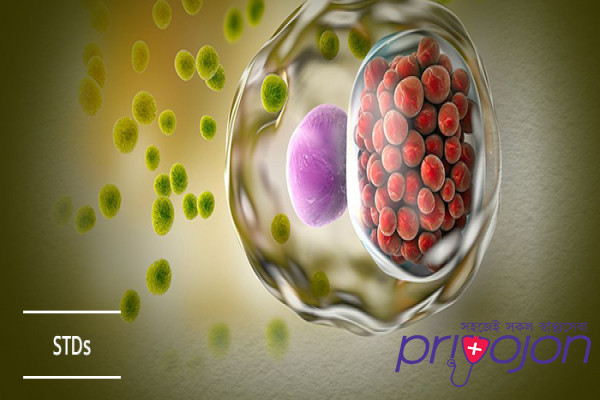Shared on 29-02-2020
Understanding Sexually Transmitted Diseases (STDs)
Understanding Sexually Transmitted Diseases (STDs)

What Are STDs?
STDs used to be called venereal diseases or VD. They are among the most common contagious diseases. More than 65 million Americans have an incurable STD. Each year, 20 million new cases are reported; half of these infections are among people ages 15 to 24 and they can have long-term consequences.
STDs are serious illnesses that require treatment. Some STDs, such as HIV, cannot be cured and can be deadly. By learning more about STDs, you can learn ways to protect yourself.
You can get a STD from vaginal, anal, or oral sex. You can also be infected with trichomoniasis through contact with damp or moist objects such as towels, wet clothing, or toilet seats, although it is more commonly spread by sexual contact. You are at high risk if:
You have more than one sex partner
You have sex with someone who has had many partners
You don't use a condom when having sex
You share needles when injecting intravenous drugs
You trade sex for money or drugs
HIV and herpes are chronic conditions that can be managed but not cured. Hepatitis B also may become chronic but can be managed. You may not realize you have certain STDs until you have damage to your reproductive organs (rendering you infertile), your vision, your heart, or other organs. Having an STD may weaken the immune system, leaving you more vulnerable to other infections. Pelvic inflammatory disease (PID) is a complication of gonorrhea and chlamydia that can leave women unable to have children. It can even kill you. If you pass an STD to your newborn child, the baby may suffer permanent harm or death.
What Causes STDs?
STDs include just about every kind of infection. Bacterial STDs include chlamydia, gonorrhea, and syphilis. Viral STDs include HIV, genital herpes, genital warts (HPV), and hepatitis B. Trichomoniasis is caused by a parasite.
The germs that cause STDs hide in semen, blood, vaginal secretions, and sometimes saliva. Most of the organisms are spread by vaginal, anal, or oral sex, but some, such as those that cause genital herpes and genital warts, may be spread through skin contact. You can get hepatitis B by sharing personal items, such as toothbrushes or razors, with someone who has it.
What are the Symptoms of STDs?
STDs don’t always cause symptoms. You can have an STD even if you and your partner feel fine. Symptoms can also come and go over time, but that doesn’t mean the STD is gone.
You can pass an STD to a partner even if you don’t have symptoms. That’s why it’s important to get tested if you think you’ve been exposed to an STD.
When STDs do have symptoms, they may include:
- Sores, bumps, or warts on and around your mouth, anus, penis, or vagina
- Swelling or redness near the penis or vagina
- Severe itching, pain, or irritation on or around the penis, vagina, vulva, or anus
- Skin rash
- Pain or burning when you pee or having to pee a lot
- Painful ejaculation
- Weight loss, loose or discolored stools, night sweats
- Flu-like symptoms such as fever, body aches, chills, swollen glands, and feeling tired
Yellowing of the skin (jaundice)
- Discharge from the vagina that’s different from usual (different odor, color, amount, or associated with irritation)
- Discharge from the penis
- Bleeding from the vagina other than during a monthly period
- Painful sex
Why should I get tested?
Most STDs are treatable with medicine. Left untreated, some STDs can cause serious health problems such as infertility in women and men. They can also raise your risk for getting more STDs such as HIV.
STDs can be spread even when you don’t have symptoms. Getting tested is the only way to know for sure if you are infected. The sooner you know, the faster you can get treatment to protect yourself against long-term health problems and prevent spreading it to others. This is especially important if you are pregnant because STDs may be passed to your baby and may cause complications during birth.
What else do I need to know?
- Tests are for adults age 18 and older. People under age 18 should see their doctor.
- Conditions that are not STDs can have some of the same symptoms, such as bacterial vaginosis, yeast infections, prostatitis, and urinary tract infections(UTIs). If your test says you don't have an STD and you are still having symptoms, call your doctor. You may have another condition, or the test may have been done too early to spot the STD and you need to take the test again.
- If your test shows that you have an STD, follow your doctor's recommendation for when it is safe for you to have sex.
- Talk to your partner about your STD status and encourage them to get tested and treated, if needed.
- For some STDs, your doctor may recommend getting tested again after treatment is finished to make sure the infection is gone.
- You can get an STD even if you've had one in the past.
- If your test shows you have an STD (with the exception of HSV-1), you will receive a call from a member of the PWNHealth Care Coordination Team who will share your results with you and advise you on the next steps you should take. You also have the option of speaking with a physician during this process.
- The testing being offered here is confidential but not anonymous. It requires your name and credit card information. Anonymous testing options are available at in-person specialized testing centers.
- If you have any questions at any point in the process, contact customer support at (855) 999-3358 or email help@labs.webmd.com.
- Test requests are evaluated and, if appropriate, authorized by a board-certified physician licensed in your state.
What Are STDs?
STDs used to be called venereal diseases or VD. They are among the most common contagious diseases. More than 65 million Americans have an incurable STD. Each year, 20 million new cases are reported; half of these infections are among people ages 15 to 24 and they can have long-term consequences.
STDs are serious illnesses that require treatment. Some STDs, such as HIV, cannot be cured and can be deadly. By learning more about STDs, you can learn ways to protect yourself.
You can get a STD from vaginal, anal, or oral sex. You can also be infected with trichomoniasis through contact with damp or moist objects such as towels, wet clothing, or toilet seats, although it is more commonly spread by sexual contact. You are at high risk if:
You have more than one sex partner
You have sex with someone who has had many partners
You don't use a condom when having sex
You share needles when injecting intravenous drugs
You trade sex for money or drugs
HIV and herpes are chronic conditions that can be managed but not cured. Hepatitis B also may become chronic but can be managed. You may not realize you have certain STDs until you have damage to your reproductive organs (rendering you infertile), your vision, your heart, or other organs. Having an STD may weaken the immune system, leaving you more vulnerable to other infections. Pelvic inflammatory disease (PID) is a complication of gonorrhea and chlamydia that can leave women unable to have children. It can even kill you. If you pass an STD to your newborn child, the baby may suffer permanent harm or death.
What Causes STDs?
STDs include just about every kind of infection. Bacterial STDs include chlamydia, gonorrhea, and syphilis. Viral STDs include HIV, genital herpes, genital warts (HPV), and hepatitis B. Trichomoniasis is caused by a parasite.
The germs that cause STDs hide in semen, blood, vaginal secretions, and sometimes saliva. Most of the organisms are spread by vaginal, anal, or oral sex, but some, such as those that cause genital herpes and genital warts, may be spread through skin contact. You can get hepatitis B by sharing personal items, such as toothbrushes or razors, with someone who has it.
What are the Symptoms of STDs?
STDs don’t always cause symptoms. You can have an STD even if you and your partner feel fine. Symptoms can also come and go over time, but that doesn’t mean the STD is gone.
You can pass an STD to a partner even if you don’t have symptoms. That’s why it’s important to get tested if you think you’ve been exposed to an STD.
When STDs do have symptoms, they may include:
- Sores, bumps, or warts on and around your mouth, anus, penis, or vagina
- Swelling or redness near the penis or vagina
- Severe itching, pain, or irritation on or around the penis, vagina, vulva, or anus
- Skin rash
- Pain or burning when you pee or having to pee a lot
- Painful ejaculation
- Weight loss, loose or discolored stools, night sweats
- Flu-like symptoms such as fever, body aches, chills, swollen glands, and feeling tired
Yellowing of the skin (jaundice)
- Discharge from the vagina that’s different from usual (different odor, color, amount, or associated with irritation)
- Discharge from the penis
- Bleeding from the vagina other than during a monthly period
- Painful sex
Why should I get tested?
Most STDs are treatable with medicine. Left untreated, some STDs can cause serious health problems such as infertility in women and men. They can also raise your risk for getting more STDs such as HIV.
STDs can be spread even when you don’t have symptoms. Getting tested is the only way to know for sure if you are infected. The sooner you know, the faster you can get treatment to protect yourself against long-term health problems and prevent spreading it to others. This is especially important if you are pregnant because STDs may be passed to your baby and may cause complications during birth.
What else do I need to know?
- Tests are for adults age 18 and older. People under age 18 should see their doctor.
- Conditions that are not STDs can have some of the same symptoms, such as bacterial vaginosis, yeast infections, prostatitis, and urinary tract infections(UTIs). If your test says you don't have an STD and you are still having symptoms, call your doctor. You may have another condition, or the test may have been done too early to spot the STD and you need to take the test again.
- If your test shows that you have an STD, follow your doctor's recommendation for when it is safe for you to have sex.
- Talk to your partner about your STD status and encourage them to get tested and treated, if needed.
- For some STDs, your doctor may recommend getting tested again after treatment is finished to make sure the infection is gone.
- You can get an STD even if you've had one in the past.
- If your test shows you have an STD (with the exception of HSV-1), you will receive a call from a member of the PWNHealth Care Coordination Team who will share your results with you and advise you on the next steps you should take. You also have the option of speaking with a physician during this process.
- The testing being offered here is confidential but not anonymous. It requires your name and credit card information. Anonymous testing options are available at in-person specialized testing centers.
- If you have any questions at any point in the process, contact customer support at (855) 999-3358 or email help@labs.webmd.com.
- Test requests are evaluated and, if appropriate, authorized by a board-certified physician licensed in your state.
Medically reviewed by
Dr. Rabeya Afroz Shomi
MBBS, FCPS, Dhaka Medical
3 Years of Experience
- Written by the Priyojon Editorial Team
